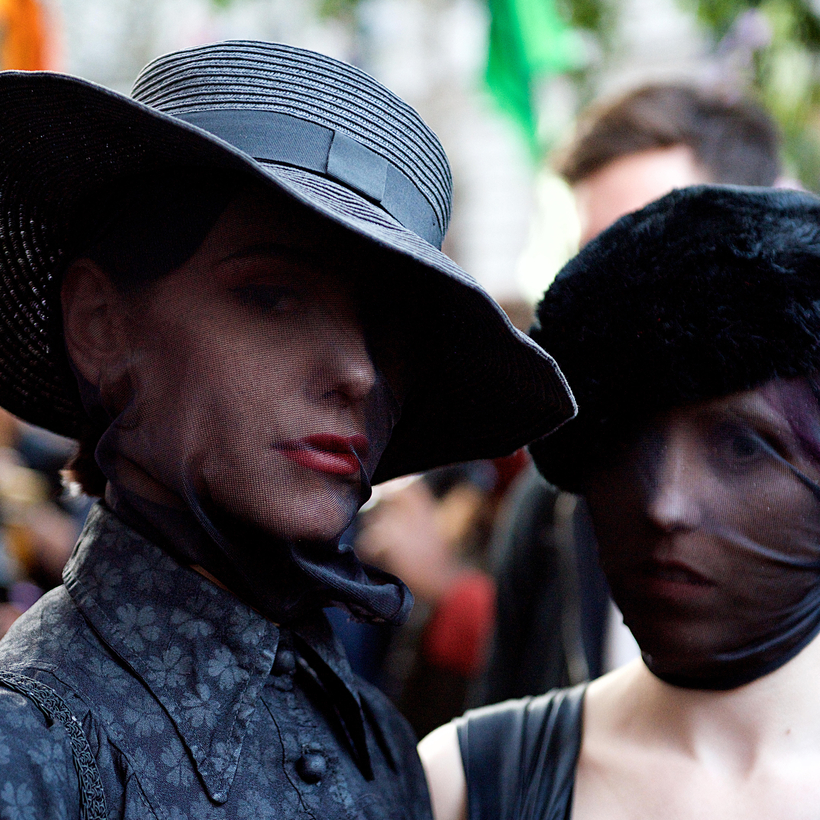September’s London Fashion Week began with a bloodbath and ended with a funeral. Both were productions of Extinction Rebellion (XR), a climate-change protest movement with a taste for the dramatic. XR has been stopping the traffic in London and across the U.K.—not metaphorically, or not only metaphorically—since declaring itself at Halloween 2018. Run mostly by volunteers, funded by donations, it has announced October 7 to be the start of an “International Rebellion,” with actions planned in major cities across the world, including New York.
The Fashion Week bloodbath involved protesters wearing sheets stained with fake blood, pouring buckets of red liquid over the pavement to create a “bleeding red carpet” outside the venue for the catwalk shows, while others glued themselves to the main entrance, and still more staged a “die-in” on the street. The aim was to shame the fashion industry for its contribution to the global climate crisis.
The funeral, four days later, was for all of humanity. (Consider yourself buried.) Around 200 Extinction Rebels processed from Trafalgar Square down the Strand. Some were dressed in widow’s black, with veils. Some carried roses, others coffins. A group in shredded red garments and with ghostly pale faces performed a ceremony; there is a pronounced element of Grand Guignol to Extinction Rebellion’s aesthetic.
Between these two events, activists “swarmed” the Victoria Beckham show, holding up signs displaying Extinction Rebellion’s logo, an angular egg timer inside a circle: a countdown to the death of the planet. T-shirts—pre-owned—were printed with slogans: Fashion = Ecocide, Fuck Consumerism. Adding to the countercultural, spirit-of-’68, situationist vibe: the movement’s punk-rock branding—the font looks like it might have been drawn by Sex Pistols’ propagandist Jamie Reid—and the fact that many of the demonstrators were young and kind of cool-looking. Like earlier XR demos—closing London’s bridges to traffic, gluing someone to the gates of Buckingham Palace, occupying the offices of dear old Greenpeace, which at a stroke was made to look prehistoric—it was all very Instagrammable.
There is a pronounced element of Grand Guignol to Extinction Rebellion’s aesthetic.
Presumably to his frustration, the group’s most prominent figure, Roger Hallam, couldn’t be at Fashion Week to witness the funereal high jinks. He was out to the west of London being arrested, and later charged, for “attempting to cause a public nuisance” near Heathrow Airport. This was part of an action under the auspices of Heathrow Pause, a separate organization to XR, opposed to the planned expansion of Europe’s busiest airport, which it describes as a “crime against humanity.”

At the time of this writing, Hallam was in custody awaiting trial. “I will be fine,” he reassured his comrades from his cell. “Don’t worry about me. I have my books and paper to write on.” He added: “It is an honor and a privilege to be in rebellion with you.”
Hallam, whose first name is actually the rather cavalier Julian—the more workman-like Roger is his middle name—is 53, slender as a roll-up cigarette, with his wispy gray hair pulled back into a ponytail, like a Monty Python prophet or a retired folk singer. He favors plaid shirts and appears to be wearing Billy Connolly’s goatee.
Their co-founder, Roger Hallam, looks like a Monty Python prophet or a retired folk singer.
Hallam is described as a co-founder of Extinction Rebellion, but there are around 15 people currently glorying in that title; Hallam might be said to be the movement’s chief ideologue. Originally from Manchester, the son of a factory-manager father (very Mancunian job) and a Methodist-preacher mother, he ran an organic farm in Wales until his 40s, when his conversion to the cause of fighting climate change began in full, after extreme weather destroyed his crops and he went bankrupt.
He then began a Ph.D. in civil-disobedience movements at King’s College, London. The Sunday Times, somewhat dismissively, calls him “Dr. Demo.” The impulse behind this snarkiness? Unlike the more youthful Thunbergian Rebels, Hallam conforms to a crusty British archetype: the hard-left, intellectual man of the people whom the people, to his consternation, have often found insufferable. Chiefly because he appears to lack that most nationally celebrated of qualities: a sense of his own ridiculousness.
In the 1970s, when this archetype was at his most virile and agitating, this hairy haunter of the halls of academe was best skewered by Private Eye, the British Establishment’s anti-Establishment satirical paper of choice. He was called “Dave Spart,” and he burned with the zeal of the righteous, while delivering long and unintelligible speeches. He still makes very occasional appearances in Private Eye, as co-chair of the Tufnell Park Pro-Tidal-Windfarm Anti-Fracking Save-the-Badger-Not-the-Bankers Socialist Alliance.
They are a climate-change protest group with a taste for the dramatic.
Dave Spart was a marginal figure then, who mostly disappeared from the pages of Private Eye as, first, Mrs. Thatcher’s Conservatives and, later, Tony Blair’s New Labour squashed—it seemed forever—the dreams of British socialists. But this is a febrile time in the U.K., as elsewhere. Insurrection is felt not only in the air and on the streets but at the highest levels of government. Jeremy Corbyn, the saturnine leader of Her Majesty’s Opposition, is a Spartist. And if five years ago Roger Hallam might have looked like a hopeless throwback, today he is a hero to a generation of committed environmental activists.

That Hallam’s recently self-published, crowd-funded book, Common Sense for the 21st Century (The Uninhabitable Earth, with fewer jokes), is named, without shame, after Thomas Paine’s famous pamphlet, from 1776, gives perhaps more of the measure of the man than he might have imagined. That, elsewhere, he unabashedly draws parallels between his own activities and those of Martin Luther King Jr. and Mahatma Gandhi does not necessarily lessen the force and power of his message.
Extinction Rebellion’s ambition is not modest. “Mass mobilization to structurally change the global economy in the next 12 months” is how Hallam puts it in a video posted to YouTube. “Radical system change on a scale never seen before” is how it’s described in This Is Not a Drill: An Extinction Rebellion Handbook, published by Penguin earlier this year.
Hallam unabashedly draws parallels between his own activities and those of Martin Luther King Jr.
Hallam is a contributor to that pink-jacketed book, offering a capsule account of the arguments given fuller expression in his own book: We are living through an existential emergency of our own making. Only mass non-violent civil disobedience can change humanity’s present suicidal course.
“Conventional campaigning has failed to bring about the necessary change,” Hallam writes. “You can only do it by disruption.” He lists the requirements of effective disruption, including: “You need the numbers,” “You have to break the law,” “It has to stay non-violent,” “It has to go on day after day.” And, finally, “It has to be fun.”
“If we can’t dance at it,” writes Hallam, “it isn’t a real revolution.” To which the cynic responds: Calm down, Granddad. But perhaps this is no time for cynics.
“See you on the streets,” signs off Hallam.
Chances are we will. Though not on October 7, when he will still be in custody, awaiting trial.
Alex Bilmes is Editor in Chief of British Esquire


